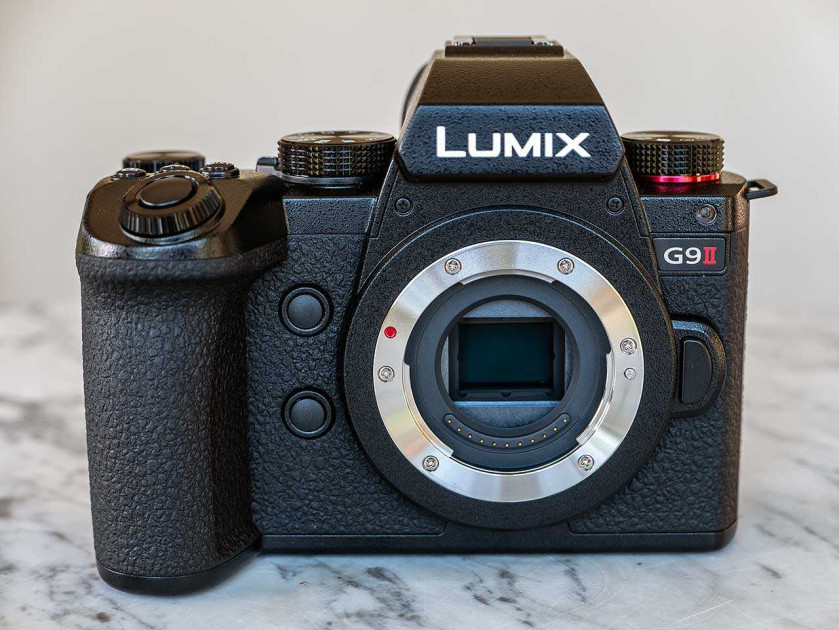
Introduction
The Panasonic Lumix G9 II is a flagship hybrid mirrorless camera with a Micro Four Thirds sensor that’s aimed at both stills photographers and videographers.
The biggest news for the G9 II is that it’s the first ever Lumix Micro Four Thirds G-series camera to use a hybrid contrast and phase-detection auto-focus (PDAF) system, something that Panasonic fans have been asking for for a long time. All previous Lumix MFT cameras, including the original Panasonic G9, have utilised a slower contrast-based AF system.
Using AI-powered recognition technology, the G9 II’s AF system now recognises cars and motorcycles and it can differentiate between the body and eye of an animal.
The new 25.2-megapixel Live MOS sensor with no low-pass filter provides high resolution and high-speed response and an ISO range of 50-25,600. The new Venus Engine processor with L² technology is 2x faster than the previous generation processor used in the G9.
The G9 II offers 60fps burst shooting with continuous auto-focusing and 75fps with the focus and exposure locked at the first frame with the larger buffer allowing around 3 seconds of shooting time.
The special Pre-burst shooting mode means that the camera begins shooting up to 1.5 seconds before the shutter is released and takes approximately 113 consecutive shots, helping to avoid missing that decisive moment.
There’s an impressive 8-stops of in-body image compensation (IBIS) and 7.5 stops of 5-axis dual image stabilisation when used with compatible lenses.
The special High Resolution mode delivers 100 megapixel images (11,552 x 8,672-pixels) for the ultimate quality when detail really matters and it works hand-held as well as with the camera mounted on a tripod.
The REAL TIME LUT function enables personalized color expression through the use of LUT files, whilst the enhanced LEICA Monochrome photo style mode creates deep black-white contrasts.
The G9II supports up to 5.8K 60p and 4K/C4K 120p 10-bit 4:2:2 or 4:2:0 video recording, Apple ProRes 422 HQ and ProRes 422 can be recorded to an external SSD recorder, and V-Log/V-Gamut is built-in which provides 13+ stops of wide dynamic range.
The splash- and dust-proof G9 II also offers built-in Wi-Fi and Bluetooth connectivity, 1/8,000th top mechanical shutter speed and 1/32,000th using the completely silent electronic shutter, 1/250th second flash sync speed, 1,728-zone metering system, a 3,680K-dot OLED electronic viewfinder with 120fps frame rate, a 1.84M pixel 3-inch swivelling and tilting LCD screen, touchscreen control system with touch-based functions like Touch AF/AE and Touch Shutter, dual SD UHS-II memory card slots, support for recording and playback using an external SSD, and USB-C charging.
The Panasonic Lumix G9 II is made in China. It’s available in black only, priced at £1,699 / €1,899 body only in the UK and USA respectively.
It’s also available in two different kits, with the Lumix G Vario 12-60mm F3/5-5.6 lens for £1,899 / €2,099 and with the Leica DG Vario-Elmarit 12-60mm F2.8-4.0 lens for £2,249 / €2,499.
Ease of Use
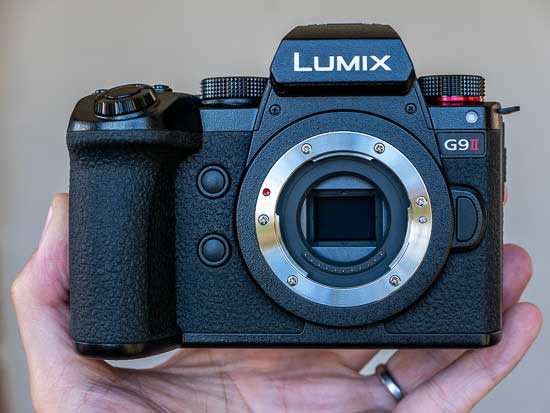 |
The Lumix G9 II is the first ever Panasonic G-series camera to support Phase Detection Auto-Focus, following on from the S5 II full-frame model released earlier this year which was the first ever Panasonic camera, full-stop, to support PDAF.
For many Panasonic fans, this will be both an enormous relief and reason enough to buy the G9 over, say, the GH6 or previous G9 models.
Simply put, phase detection is a very big deal for the G9 II and more generally Panasonic cameras, which will presumably all support this feature in future releases.
Offering fast and dependable 779-area metering, the new AF system is able to detect target subjects in difficult conditions such as low light and backlighting and, once locked on, will remain tracking them even with other moving objects in the frame.
There’s no sign of the G9’s characteristic “pulsing” effect in the continuous AF-C mode as that camera’s DFD system scans back and forth, so if effective continuous auto-focusing is top of your requirements list, then it’s definitely worth choosing the newer G9 II model with its superior AF system.
The brand new PDAF autofocus system is not the only thing that the new G9 II shares with its larger-sensor cousin. Somewhat controversially and despite having a much smaller sensor inside it, the G9II almost exactly mimics the size, weight and control layout of the S5 II.
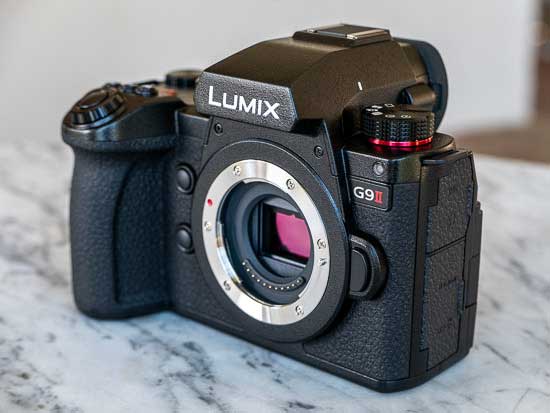 |
Indeed, apart from the difference in sensor size that becomes apparent when you remove the lens, you’d be hard-pressed to tell the G9 II and S5 II apart. Current G9 owners will face a learning curve when they upgrade to the G9 II, whilst S5 owners will feel instantly at home, such is the similarity between them and the G9 II.
If you’ve bought in to the Micro Four Thirds system because it usually offers the advantage of smaller camera bodies (and in turn lenses), then you’ll probably be disappointed at just how large the Lumix G9 II is.
Measuring 134.3 x 102.3 x 90.1 mm / 5.29 x 4.03 x 3.55 inch, the G9II is actually exactly the same size as the S5II, which may disappoint those who value the compactness of most Micro Four Thirds cameras.
It is quite a bit lighter though, weighing in at 658g / 1.45 lb with a battery and memory card fitted versus the 740g S5II. The original G9 measured 136.9 x 97.3 x 91.6 mm and weighed 579g body only, so it was a little more compact and 79g lighter than the new Mark II version.
On the other hand, the S5 II is a remarkably small and compact full-frame camera that’s actually smaller than the popular Lumix GH6, so the fact that the G9 II is virtually identical to the S5 II shouldn’t necessarily be a show-stopper.
The status LCD on the top-panel of the original G9 has been removed on the 2023 version to make way for the new separate drive and shooting mode dials that are positioned on either side of the viewfinder, and the G9’s slanted top-panel has made way for the much squarer design of the G9 II.
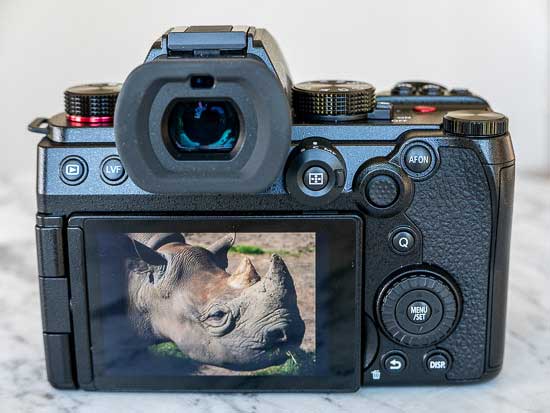 |
The G9 II also now benefits from inheriting the same 8-way joystick, expanded drive dial, 3.0-inch free-angle touch-control monitor and large, 3,680K-dot OLED Live View Finder as the S5 II.
The G9 II has a familiar DSLR style with the viewfinder in the centre, a large tactile hand grip, and a healthy array of logically placed controls.
It also shares the same tank-like build quality and weather-proof exterior shared by all of the other Lumix S-series cameras, with a magnesium alloy full die-cast dust and splash-proof body that has all of its main seams tightly sealed against moisture ingress.
The Lumix G9 II has an OLED electronic viewfinder that offers 100% field of view, 10000:1 contrast ratio, 21mm eye-point and 3,680K-dot resolution, and operates at a native rate of 120fps with a minimum lag of less than 0.005 sec, which helps make it completely flicker-free., exactly the same as its predecessor, although strangely the magnification is ever so slightly lower at 0.80x versus 0.83x on the G9.
Both old and new G9 variants have a fully articulating 3-inch, 3:2 ratio, free-angle design LCD touch-screen which means that you can flip it out to the side, rotate it forwards for easier operation when pointing the camera at yourself, and fold it flat against the back of the camera to stop it from getting scratched.
The Lumix G9 II has a much higher-resolution LCD screen than the Lumix G9 though, with 1.84 million dots versus 1.04 million dots on the original model.
 |
This new camera continues to offer the same dual image stabilisation system (in-body IS and lens IS) that’s employed by the G-series series for more effective, shake-free shooting when handled in lower lighting conditions.
This provides a whopping 8-stops of in-body image compensation (IBIS) and 7.5 stops of 5-axis dual image stabilisation when used with compatible lenses, instantly putting the G9 II right at the top of its particular class.
The G9 II additionally has an Active I.S. mode which provides highly stable video recording by optimising horizontal, vertical and rotational correction. This is especially effective in traditionally challenging conditions for handheld shooting, such as using telephoto lenses or filming while walking.
Turning to the front of the Lumix G9 II, the lens mount dominates proceedings, along with a deep hand grip that feels just right in the hand, enabling the camera to be operated with just one hand.
With the lower three fingers of your right hand curled around the G9 II’s grip, your forefinger is free to alternate between rotating the front control dial that sits slightly proud of the grip at its topper-most edge, and the slightly raised and angled shutter release button just atop it, which is responsively springy.
Sitting just behind these controls are three small raised buttons, just like on the S5 II. From left to right, these are for manually adjusting white balance, light sensitivity and exposure settings.
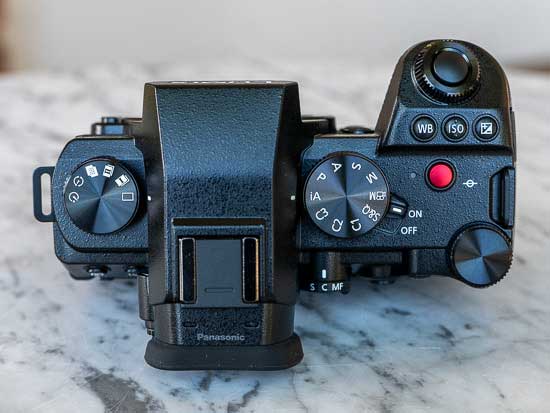 |
There’s no top-plate LCD screen on the new Lumix G9 II. Instead there’s a large shooting mode dial on the top-right and a Burst/Bracketing Shooting dial on the top-left.
This smaller but still chunky, roughly ridged and raised dial over at the left hand edge of the camera has 6 different settings, which variously provide quick access to the self-timer, time-lapse, high resolution, burst shooting (2 modes) and normal single shooting modes.
Underneath the dial is a shiny red ring, just like on the S1-series cameras, which has perhaps been deployed to lend the cameras a more professional air.
Stereo microphones and a vacant hotshoe for an accessory flash are slotted directly on top of the EVF. Interestingly there’s no built-in pop up flash on the Panasonic G9 II, which is maybe a slightly surprising omission for a mid-range camera.
The chunky, roughly ridged and raised shooting mode dial over on the top-right makes it easy to adjust settings ranging from Intelligent Auto focus to program, shutter priority, aperture priority or manual pretty quickly.
On the same dial we also get a manual video mode setting, an S&Q setting, and no fewer than three custom modes. In the S(low)&Q(quick) shooting mode, the G9 II can capture Full HD video at up to 180fps and then play back the videos at 24p, 30p, or 60p.
 |
The On/Off switch is more of an actual lever which sits adjacent to the shooting mode dial. This is quite stiff in operation – you almost have to force it – which, to give it a positive spin, means this is a camera that is almost impossible to accidentally activate or deactivate.
The control dial at the front of the handgrip is, incidentally, mirrored by one the size of a five pence piece that sits recessed into the top plate at the back. Here it readily (and again, ergonomically) falls under the thumb of the right hand.
Completing the G9 II’s top-plate is a one-touch movie record button, finished in the same metallic dark red as the ring which sits underneath the drive mode dial. Just like the shutter release button, again this has a nice springy feel to it that makes it easier to locate and activate.
The new G9II completely out-performs the 6-year-old G9 in terms of video, as you’d perhaps expect, and is definitely the camera to go for if you’re a hybrid photo/video shooter.
It supports up to 5.7K 60p and 4K/C4K 120p 10-bit 4:2:2 or 4:2:0 recording, depending on the specific mode – 5.7K (17:9) 30p/25p and C4K/4K 120p/100p are 4:2:0 10-bit.
ProRes 422 HQ and ProRes 422 can be recorded to an external SSD recorder with one caveat – if you’re recording more than 60fps to the SSD it requires an additional external power source.
 |
5.8K 30p/25p/24p 4:2:0 10-bit anamorphic 4:3 modes are recorded utilising the full area of the sensor and there are also 4.4K 60p/50p/48p modes.
The Lumix G9 II has V-Log/V-Gamut built-in which provides 13+ stops of wide dynamic range, and the Dynamic Range Boost mode expands it to 14+ stops.
The G9II uses the full area of the sensor to record then downsamples it in-camera, which means that your framing won’t be cropped when composing.
With lugs for attaching the shoulder strap provided out of the box to be found left and right of the camera, the right-hand flank provides a port protected by a sliding switch that allows for the insertion of two SD UHS-II cards, both of which support the faster SD UHS-II memory card standard.
The two ports on the left-hand flank provide a means of connecting an accessory microphone and headphones, plus USB-C and a full-size HDMI port. The rubberized flaps protecting these feel a little flimsier than the rest of the camera, and time will tell whether these become worn and stop adhering so precisely over time.
Moving to the rear of the Panasonic G9 II, again this is button festooned without being over-bearingly so.
 |
The camera’s 3-inch LCD screen with 1.84m-dot resolution is also a touch screen, meaning that you can drag the focus area around the screen with your finger or thumb. Alternatively, if you prefer physical controls, you can use the small thumb-operated joystick to the upper-right of the LCD to do the same.
The G9II has a conventional free-angle screen that’s hinged on the left-hand side. This can be tilted all the way out to the side of the camera, turned forwards for selfies and vlogging, and turned towards the back of the camera to help protect it when the camera isn’t being used. It’s very useful as an aid to shooting video as well as more unusual compositions when you can’t always get an eye flush to the viewfinder.
The top-left of the back of the camera is where we find the playback button for reviewing stills and video. There’s also a dedicated LVF button alongside it for manually switching between the rear LCD screen and the EVF, which perhaps feels a little redundant given that the camera automatically switches to the EVF when you hold the camera up to your eye (this setting can be turned on and off as desired).
Directly to the right of the EVF is a tactile circular switch for changing the auto-focus mode from single to continuous to manual focus, into which is set the AF area button for selecting one of the seven available AF modes. You can choose from Tracking, Full Area, Zone (Horizontal/Vertical), Zone, 1-Area+, 1-Area and Pinpoint.
Along with the afore-mentioned AF joystick, the small AF On which can be used for back-focusing completes the G9 II’s very handily-placed collection of focusing controls.
This being a Panasonic camera, we’re provided with the very useful Quick menu short cut button – located via the button marked with an enigmatic ‘Q’ situated to the right of the LCD – which gives completely customizable quick access to 12 of the camera’s key settings.
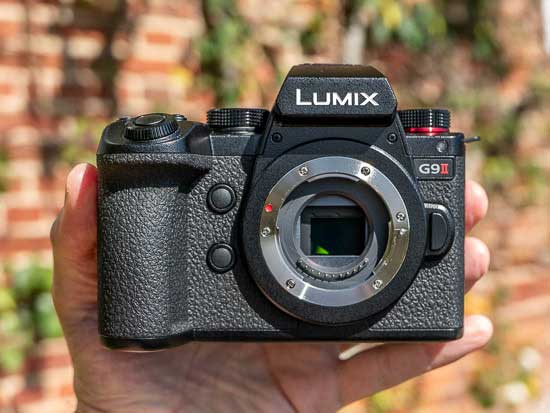 |
Menu/Set, Display and a shared delete/back button are also to be found at the rear of the G9 II, along with a familiar multi-directional control pad, encircled by a scroll wheel for maximum fluidity of operation.
The menu screens are, as expected, comprehensively featured but pleasingly legible and intuitively navigated. That said it was also nice to have the Quick menu feature in order to circumnavigate them when we knew what we wanted and wanted to get to the relevant setting swiftly.
At the base of the camera we find a single screw thread, located directly in line with the central point of the lens mount, for attaching the G9 II to a tripod.
Also found here, nestled within the base of the G9 II’s handgrip is the same rechargeable 2,200mAh DMW-BLK22 lithium-ion battery that’s used in the S5 II. The previous Lumix G9 uses the DMW-BLF19 battery, so you can’t use G9 batteries in the G9II and vice-versa.
Battery life is actually very similar at around 380 shots on the G9 when using the Live Viewfinder and 400 using the LCD screen, and 390 shots on the G9 II using either the EVF or LCD.
Both cameras can also be powered and charged via a USB connection, which is useful if you’re out and about and have a compatible powerbank to plug the camera into, but the G9 II uses the newer USB-C 3.2 variant.
A ‘proper’ charger with its own mains plug is also provided out of the box – or at least it was with our fully working review sample – and you can also charge the camera whilst you’re out and about by attaching a power-bank to the USB-C port. Note that the G9 II supports the latest USB 3.2 Gen 2 standard whereas the G9 only supported the Micro USB 3.0 spec port.
Image Quality
All of the sample images in this review were taken using the 25.2 megapixel Fine JPEG setting, which produces an average image size of around 13Mb.
The G9 II is the latest Panasonic Micro Four Thirds camera to push past the 20 megapixel barrier, utilising a brand new 25.2-megapixel Live MOS Sensor with no low-pass filter and phase-detection AF.
The Panasonic Lumix G9 II produced images of outstanding quality during the review period. It produces noise-free images at ISO 100 to 1600, with limited noise starting to appear at ISO 3200. ISO 6400 and 12800 exhibit quite visible noise and loss of fine detail, while the fastest setting of 25600 looks much better on paper than in reality.
The various Photo Styles and Filters allow you to quickly and easily customise the look of the camera’s JPEG and Raw images before you take them. The night photograph was excellent, with the maximum shutter speed of 60 seconds and Bulb mode of up to 30 minutes allowing you to capture plenty of light.
The High Resolution Mode successfully creates much larger 50 or 100 megapixel images and can be employed when the camera is mounted on a tripod and also hand-held. It’s still best reserved for use with non-moving subjects.
Noise
There are 10 different ISO settings available on the Panasonic Lumix G9 II which you can select at any time if the camera is in one of the creative shooting modes. Here are some 100% crops which show the noise levels for each ISO setting for both JPEG and RAW formats.
| JPEG | RAW |
|
ISO 50 |
ISO 50 |
 |
 |
|
ISO 100 |
ISO 100 |
 |
 |
|
ISO 200 |
ISO 200 |
 |
 |
|
ISO 400 |
ISO 400 |
 |
 |
|
ISO 800 |
ISO 800 |
 |
 |
|
ISO 1600 |
ISO 1600 |
 |
 |
|
ISO 3200 |
ISO 3200 |
 |
 |
|
ISO 6400 |
ISO 6400 |
 |
 |
|
ISO 12800 |
ISO 12800 |
 |
 |
|
ISO 25600 |
ISO 25600 |
 |
 |
File Quality
The Panasonic Lumix G9 II has 2 different JPEG image quality settings available, with Fine being the highest quality option. Here are some 100% crops which show the quality of the various options, with the file size shown in brackets.
|
Fine JPEG (14Mb) |
Standard JPEG (7.1Mb) |
 |
 |
|
Raw (36.5Mb) |
|
 |
High Resolution Mode
The Panasonic Lumix G9 II’s High Resolution Mode combines 8 shots in-camera into a 100 megapixel image to create a super high-resolution photo. There’s also a smaller 50.5 megapixel setting available.
|
Off (100% Crop) |
On (100% Crop) |
 |
 |
Long Exposures
The Panasonic Lumix G9 II’s maximum shutter speed is 60 seconds and there’s also a Bulb option for exposures up to 30 minutes long, which is excellent news if you’re seriously interested in night photography.
The shot below was taken using a shutter speed of 30 seconds at ISO 100. If the Long Exposure NR main menu option is set to ON, the camera takes the same amount of time again to apply noise reduction, so for example at the 15 second setting the actual exposure takes 30 seconds.

Photo Styles
Panasonic’s Photo Styles are preset combinations of different sharpness, contrast, saturation and noise reduction settings. The 16 available Photo Styles are shown below in the following series, which demonstrates the differences. There are also four Custom options so that you can create your own looks.
The new LEICA Monochrome mode features deep contrasts between black and white, creating brighter images on highlights and generally strong and dynamic monochrome when compared to the other B&W photo styles.
Filter Effects
The Panasonic Lumix GH6 offers a range of digital filter effects that can be applied to both JPEG and Raw files, with 8 different options available in the main menu.
|
Expressive |
 |
|
Retro |
 |
|
Old Days |
 |
|
High Key |
 |
|
Low Key |
 |
|
Sepia |
 |
|
Cross Process |
 |
|
Bleach Bypass |
 |
Sample Images
This is a selection of sample images from the Panasonic Lumix G9 II camera, which were all taken using the 25.2 megapixel Fine JPEG setting. The thumbnails below link to the full-sized versions, which have not been altered in any way.
Sample RAW Images
The Panasonic Lumix G9 II enables users to capture RAW and JPEG format files. We’ve provided some Panasonic RAW (RW2) samples for you to download (thumbnail images shown below are not 100% representative).
Sample Movies & Video
This is a sample 5.8K movie at the quality setting of 5760×4320 pixels at 25 frames per second. Please note that this 15 second movie is 292Mb in size.
This is a sample 5.8K movie at the quality setting of 5760×4320 pixels at 25 frames per second. Please note that this 11 second movie is 205Mb in size.
This is a sample 5.7K movie at the quality setting of 5728×3024 pixels at 50 frames per second. Please note that this 14 second movie is 455Mb in size.
This is a sample 5.7K movie at the quality setting of 5728×3024 pixels at 50 frames per second. Please note that this 11 second movie is 341Mb in size.
This is a sample 5.7K movie at the quality setting of 5728×3024 pixels at 25 frames per second. Please note that this 11 second movie is 205Mb in size.
This is a sample C4K movie at the quality setting of 4096×2160 pixels at 100 frames per second. Please note that this 10 second movie is 623Mb in size.
This is a sample 4K movie at the quality setting of 3840×2160 pixels at 100 frames per second. Please note that this 11 second movie is 658Mb in size.
This is a sample 4K 4.8x slow-motion movie at the quality setting of 3840×2160 pixels at 120 frames per second. Please note that this 50 second movie is 650Mb in size.
Product Images







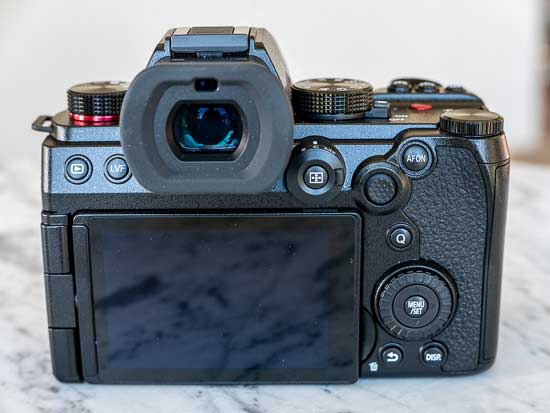
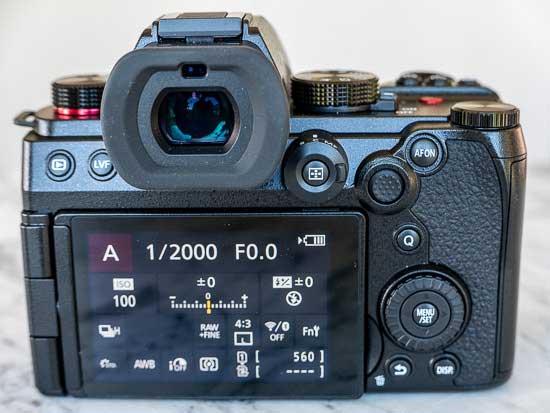




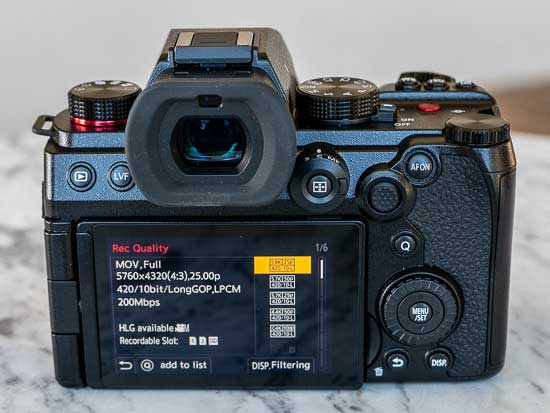
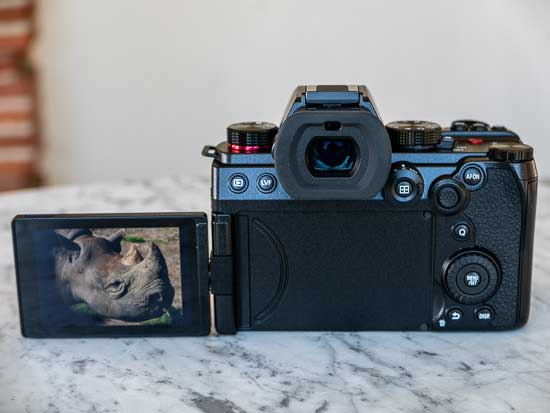




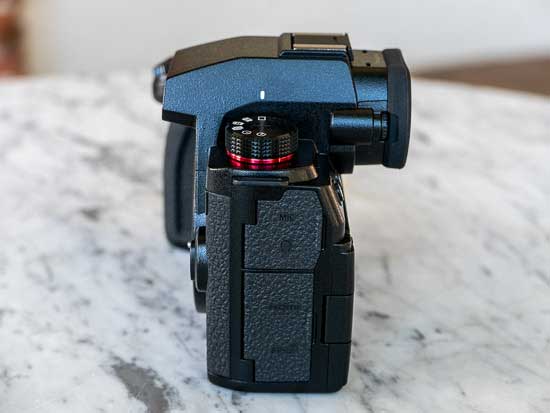

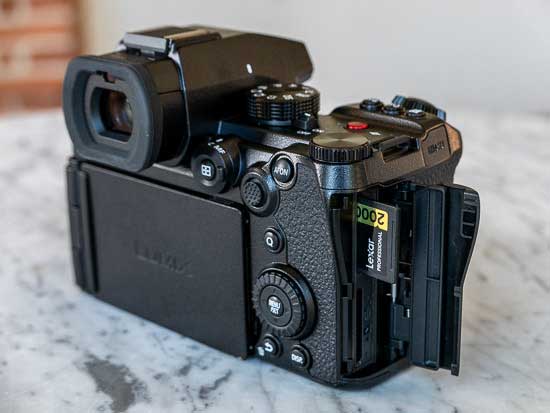
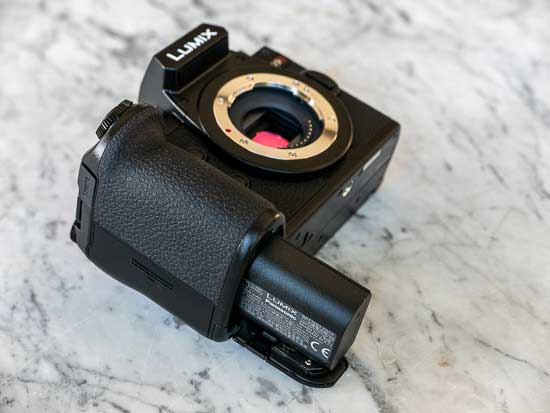

Conclusion
By far the biggest headline news is that the Lumix G9 II introduces phase-detection auto-focus for the first time on any Panasonic G-series Micro Four Thirds camera.
The distracting pulsing effect that plagued video recording in particular has now gone, replaced by a very competent, satisfyingly quick hybrid AF system complete with subject-detection that belies its first-generation status.
For many people, that will be the only reason that they need to now seriously consider buying into the Lumix system in preference to Olympus/OM System, whose most recent cameras have had PDAF for a while now.
Panasonic haven’t just rested on their focusing laurels, though, as there are also a significant number of additional upgrades that help turn the already well-regarded original G9 model into an even better Mark II edition for 2023.
60fps burst shooting with AF/AE tracking, 8 stops of IBIS, 100 megapixel High Resolution images and a video spec that rivals the GH6 make this a real powerhouse hybrid flagship camera.
Choosing between the new Panasonic Lumix G9 II and the previous Lumix G9 (which continues in the range for the time being) is something of a no-brainer – if you can afford the newer model, then go for it, as the Mark II version out-performs its 6-year-old sibling in almost every way.
It’s a much closer battle between the hybrid Panasonic Lumix G9 II and the more video-centric Lumix GH6, especially as they’re currently available at roughly the same price. The G9 II offers the main benefit of PDAF auto-focusing for the first time on a Panasonic MFT camera, but the GH6 with its built-in fan supports unlimited recording times in any video mode.
The G9 II’s main MFT rival is the OM System OM-1, which has a stacked 20mp sensor, is smaller and lighter and has a better EVF, but is a less capable video camera.
Alternatively, if you prefer the look of full-frame and can afford the extra few hundred £$, the recent S5 II offers almost identical handling and a similar feature-set to the G9 II in the same sized body.
You could also consider the very popular Fujifilm X-T5 if you’ve not yet bought into a particular camera system, which offers the principal benefits of a larger APS-C sensor and proven Fuji handling at a similar price-point to the G9 II.
Ultimately, the new G9 II is going to appeal most to current Micro Four Thirds photographers and/or videographers who want the best technologies on offer in their system, especially the auto-focusing, and don’t mind investing in what is a relatively large and expensive body to get the best out of their premium MFT lenses.
| Ratings (out of 5) | |
|---|---|
| Design | 4 |
| Features | 5 |
| Ease-of-use | 4.5 |
| Image quality | 4.5 |
| Value for money | 4 |
Main Rivals
Listed below are some of the rivals of the Panasonic Lumix G9 II.
The X-H2 is the highest resolution APS-C camera that Fujifilm have ever released, offering a 40 megapixel BSI sensor that can record 8K/30p video and shoot burst sequences at 20fps. Find out exactly what this new flagship camera is capable of and who it’s aimed at by reading our complete Fuji XH2 review complete with full-size JPEG, Raw and video samples.

The Fujifilm X-T5 is the successor to the very popular X-T4 which was released in 2020, principally adding a new 40 megapixel sensor, 160 megapixel Pixel Shift Multi-Shot mode, 6.2K video recording and better auto-focusing. Can the new XT5 improve on what was already an outstanding camera? Find out now by reading our in-depth Fujifilm X-T5 review…

The new OM-1 flagship is both the last ever Olympus camera and the first ever OM System camera. Confused? Well no need to worry, as we take an in-depth look at what this new Micro Four Thirds flagship has to offer in our OM System OM-1 review, complete with full-size sample photos and videos…

Panasonic have enjoyed a lot of success with the video-centric GH5 camera, and now they’ve turned their attention to the enthusiast and professional stills photographer with the release of the exciting new G9. Read our in-depth Panasonic G9 review now to find out more…

The much anticipated Panasonic GH6 may be on the near-horizon, but the brand new GH5 Mark II is here right now. What does the new version offer, and can it really improve on the best-selling original? We find out in our review of the Panasonic Lumix GH5 II mirrorless camera, complete with sample photos, test shots, videos and more…

The much anticipated Panasonic GH6 is finally here! But what does this new flagship camera offer, and can it really improve on the best-selling GH5? We find out in our review of the Panasonic Lumix GH6 mirrorless camera, complete with sample photos, test shots, videos and more…

Finally! The new Lumix S5 II is the first ever Panasonic camera to have a phase hybrid detection AF system, answering the critics of its contrast-based DFD system. But does this powerful hybrid photo and video camera have what it takes to beat its main rivals? Find out now by reading our in-depth Panasonic Lumix S5 II review, complete with full-size sample photos and videos.
Review Roundup
Reviews of the Panasonic Lumix G9 II from around the web.
The G9 II is a worthy flagship, packing the best autofocus and subject detection from a Lumix G to date, ultra fast shooting with pre-burst options, excellent stabilisation, great image quality, and seriously good video which in some respects out-rivals the GH6. In fact there’s little to complain about other than wondering whether investing more in a stacked sensor would have made much difference to the target audience.
Read the full review »
Specifications
-
Type
- Digital Single Lens Mirrorless camera
-
Lens mount
IMAGE SENSOR
-
Type
- Live MOS sensor (17.3 x 13.0 mm)
-
Camera effective pixels / Total pixels
- 25.21 megapixels / 26.52 megapixels
-
AR (Anti Reflection) coating
-
Aspect ratio / Color filter
- 4:3 / Primary color filter
-
Dust reduction system
LATITUDE
- 13+ stops (V-Log) (Sensor output is 60fps or less)
12+ stops (V-Log) (Sensor output is 61fps or higher)
STILL IMAGE
-
Recording file format
- JPEG (DCF, Exif 2.31), RAW
-
Aspect ratio
-
File size (Pixels)
-
4:3
- 5776×4336(L) / 4096×3072(M) / 2944×2208(S) / 11552×8672(XL)* / 8192×6144(LL)* *High Resolution Mode.
-
3:2
- 5776×3848(L) / 4096×2728(M) / 2944×1960(S) / 11552×7696(XL)* / 8192×5464(LL)* *High Resolution Mode.
-
16:9
- 5776×3248(L) / 4096×2304(M) / 2944×1656(S) / 11552×6496(XL)* / 8192×4608(LL)* *High Resolution Mode.
-
1:1
- 4336×4336(L) / 3072×3072(M) / 2208×2208(S) / 8672×8672(XL)* / 6144×6144(LL)* *High Resolution Mode.
-
-
Image quality
- RAW / RAW+Fine / RAW+Standard / Fine / Standard (High Resolution mode: Combined / RAW / RAW+Fine / Fine)
-
Color space
MOTION PICTURE
-
Recording file format
- MOV: H.264/MPEG-4 AVC, H.265/HEVC, Apple ProRes
MP4: H.264/MPEG-4 AVC, H.265/HEVC
- MOV: H.264/MPEG-4 AVC, H.265/HEVC, Apple ProRes
-
Audio format
- MOV: LPCM (2ch 48kHz/24-bit, 96kHz/24-bit*) (4ch 48kHz/24-bit**, 96kHz/24-bit**)
MP4: AAC (2ch 48kHz/16-bit)
*When attaching Φ3.5mm microphone or DMW-XLR1 (sold separately). **When attaching DMW-XLR1 (sold separately).
- MOV: LPCM (2ch 48kHz/24-bit, 96kHz/24-bit*) (4ch 48kHz/24-bit**, 96kHz/24-bit**)
-
System frequency
- 59.94Hz / 50.00Hz / 24.00Hz
-
Image area of video
-
MOV (*¹) (*²) *HLG is selectable.
-
59.94Hz [5.8K] 5760×4320 (4:3)
- 29.97p, 200Mbps (4:2:0 10-bit LongGOP) (H.265/HEVC, LPCM)*
23.98p, 200Mbps (4:2:0 10-bit LongGOP) (H.265/HEVC, LPCM)*
*Image Area of Video is set to FULL during this recording mode.
- 29.97p, 200Mbps (4:2:0 10-bit LongGOP) (H.265/HEVC, LPCM)*
-
59.94Hz [5.7K] 5728×3024 (17:9)
- 59.94p, 300Mbps (4:2:0 10-bit LongGOP) (H.265/HEVC, LPCM)*
47.95p, 300Mbps (4:2:0 10-bit LongGOP) (H.265/HEVC, LPCM)*
29.97p, 200Mbps (4:2:0 10-bit LongGOP) (H.265/HEVC, LPCM)*
23.98p, 200Mbps (4:2:0 10-bit LongGOP) (H.265/HEVC, LPCM)*
*Image Area of Video is set to FULL during this recording mode.
- 59.94p, 300Mbps (4:2:0 10-bit LongGOP) (H.265/HEVC, LPCM)*
-
59.94Hz [4.4K] 4352×3264 (4:3)
- 59.94p, 300Mbps (4:2:0 10-bit LongGOP) (H.265/HEVC, LPCM)*
47.95p, 300Mbps (4:2:0 10-bit LongGOP) (H.265/HEVC, LPCM)*
*Image Area of Video is set to PIXEL/PIXEL during this recording mode.
- 59.94p, 300Mbps (4:2:0 10-bit LongGOP) (H.265/HEVC, LPCM)*
-
59.94Hz [C4K] 4096×2160
- 119.88p, 300Mbps (4:2:0 10-bit LongGOP) (H.265/HEVC, LPCM)*
59.94p, 800Mbps (4:2:2 10-bit ALL-Intra) (H.264/MPEG-4 AVC, LPCM)**
59.94p, 600Mbps (4:2:2 10-bit ALL-Intra) (H.264/MPEG-4 AVC, LPCM)
59.94p, 200Mbps (4:2:2 10-bit LongGOP) (H.264/MPEG-4 AVC, LPCM)
59.94p, 200Mbps (4:2:0 10-bit LongGOP) (H.265/HEVC, LPCM)
47.95p, 800Mbps (4:2:2 10-bit ALL-Intra) (H.264/MPEG-4 AVC, LPCM)**
47.95p, 600Mbps (4:2:2 10-bit ALL-Intra) (H.264/MPEG-4 AVC, LPCM)
47.95p, 200Mbps (4:2:2 10-bit LongGOP) (H.264/MPEG-4 AVC, LPCM)
47.95p, 200Mbps (4:2:0 10-bit LongGOP) (H.265/HEVC, LPCM)
29.97p, 400Mbps (4:2:2 10-bit ALL-Intra) (H.264/MPEG-4 AVC, LPCM)
29.97p, 150Mbps (4:2:2 10-bit LongGOP) (H.264/MPEG-4 AVC, LPCM)
29.97p, 150Mbps (4:2:0 10-bit LongGOP) (H.265/HEVC, LPCM)
23.98p, 400Mbps (4:2:2 10-bit ALL-Intra) (H.264/MPEG-4 AVC, LPCM)
23.98p, 150Mbps (4:2:2 10-bit LongGOP) (H.264/MPEG-4 AVC, LPCM)
23.98p, 150Mbps (4:2:0 10-bit LongGOP) (H.265/HEVC, LPCM)
*An AC Adaptor DMW-AC10 (optional) and DC Coupler DMW-DCC17 (optional) are required on a USB-SSD.
**External USB-SSD recording.
- 119.88p, 300Mbps (4:2:0 10-bit LongGOP) (H.265/HEVC, LPCM)*
-
59.94Hz [4K] 3840×2160
- 119.88p, 300Mbps (4:2:0 10-bit LongGOP) (H.265/HEVC, LPCM)*
59.94p, 800Mbps (4:2:2 10-bit ALL-Intra) (H.264/MPEG-4 AVC, LPCM)**
59.94p, 600Mbps (4:2:2 10-bit ALL-Intra) (H.264/MPEG-4 AVC, LPCM)
59.94p, 200Mbps (4:2:2 10-bit LongGOP) (H.264/MPEG-4 AVC, LPCM)
59.94p, 200Mbps (4:2:0 10-bit LongGOP) (H.265/HEVC, LPCM)
47.95p, 800Mbps (4:2:2 10-bit ALL-Intra) (H.264/MPEG-4 AVC, LPCM)**
47.95p, 600Mbps (4:2:2 10-bit ALL-Intra) (H.264/MPEG-4 AVC, LPCM)
47.95p, 200Mbps (4:2:2 10-bit LongGOP) (H.264/MPEG-4 AVC, LPCM)
47.95p, 200Mbps (4:2:0 10-bit LongGOP) (H.265/HEVC, LPCM)
29.97p, 400Mbps (4:2:2 10-bit ALL-Intra) (H.264/MPEG-4 AVC, LPCM)
29.97p, 150Mbps (4:2:2 10-bit LongGOP) (H.264/MPEG-4 AVC, LPCM)
29.97p, 150Mbps (4:2:0 10-bit LongGOP) (H.265/HEVC, LPCM)
23.98p, 400Mbps (4:2:2 10-bit ALL-Intra) (H.264/MPEG-4 AVC, LPCM)
23.98p, 150Mbps (4:2:2 10-bit LongGOP) (H.264/MPEG-4 AVC, LPCM)
23.98p, 150Mbps (4:2:0 10-bit LongGOP) (H.265/HEVC, LPCM)
*An AC Adaptor DMW-AC10 (optional) and DC Coupler DMW-DCC17 (optional) are required on a USB-SSD.
**External USB-SSD recording.
- 119.88p, 300Mbps (4:2:0 10-bit LongGOP) (H.265/HEVC, LPCM)*
-
59.94Hz [FHD] 1920×1080
- 239.76p, 800Mbps (4:2:2 10-bit ALL-Intra) (H.264/MPEG-4 AVC, LPCM)*/**
239.76p, 200Mbps (4:2:2 10-bit LongGOP) (H.264/MPEG-4 AVC, LPCM)*/***
239.76p, 200Mbps (4:2:0 10-bit LongGOP) (H.265/HEVC, LPCM)*/***
119.88p, 400Mbps (4:2:2 10-bit ALL-Intra) (H.264/MPEG-4 AVC, LPCM)***
119.88p, 150Mbps (4:2:2 10-bit LongGOP) (H.264/MPEG-4 AVC, LPCM)***
119.88p, 150Mbps (4:2:0 10-bit LongGOP) (H.265/HEVC, LPCM)***
59.94p, 200Mbps (4:2:2 10-bit ALL-Intra) (H.264/MPEG-4 AVC, LPCM)
59.94p, 100Mbps (4:2:2 10-bit LongGOP) (H.264/MPEG-4 AVC, LPCM)
59.94p, 100Mbps (4:2:0 10-bit LongGOP) (H.265/HEVC, LPCM)
47.95p, 200Mbps (4:2:2 10-bit ALL-Intra) (H.264/MPEG-4 AVC, LPCM)
47.95p, 100Mbps (4:2:2 10-bit LongGOP) (H.264/MPEG-4 AVC, LPCM)
47.95p, 100Mbps (4:2:0 10-bit LongGOP) (H.265/HEVC, LPCM)
29.97p, 200Mbps (4:2:2 10-bit ALL-Intra) (H.264/MPEG-4 AVC, LPCM)
29.97p, 100Mbps (4:2:2 10-bit LongGOP) (H.264/MPEG-4 AVC, LPCM)
29.97p, 100Mbps (4:2:0 10-bit LongGOP) (H.265/HEVC, LPCM)
23.98p, 200Mbps (4:2:2 10-bit ALL-Intra) (H.264/MPEG-4 AVC, LPCM)
23.98p, 100Mbps (4:2:2 10-bit LongGOP) (H.264/MPEG-4 AVC, LPCM)
23.98p, 100Mbps (4:2:0 10-bit LongGOP) (H.265/HEVC, LPCM)
*Image Area of Video is set to FULL during this recording mode.
**External USB-SSD recording. An AC Adaptor DMW-AC10 (optional) and DC Coupler DMW-DCC17 (optional) are required.
***An AC Adaptor DMW-AC10 (optional) and DC Coupler DMW-DCC17 (optional) are required on a USB-SSD.
- 239.76p, 800Mbps (4:2:2 10-bit ALL-Intra) (H.264/MPEG-4 AVC, LPCM)*/**
-
50.00Hz [5.8K] 5760×4320 (4:3)
- 25.00p, 200Mbps (4:2:0 10-bit LongGOP) (H.265/HEVC, LPCM)*
*Image Area of Video is set to FULL during this recording mode.
- 25.00p, 200Mbps (4:2:0 10-bit LongGOP) (H.265/HEVC, LPCM)*
-
50.00Hz [5.7K] 5728×3024 (17:9)
- 50.00p, 300Mbps (4:2:0 10-bit LongGOP) (H.265/HEVC, LPCM)*
25.00p, 200Mbps (4:2:0 10-bit LongGOP) (H.265/HEVC, LPCM)*
*Image Area of Video is set to FULL during this recording mode.
- 50.00p, 300Mbps (4:2:0 10-bit LongGOP) (H.265/HEVC, LPCM)*
-
50.00Hz [4.4K] 4352×3264 (4:3)
- 50.00p, 300Mbps (4:2:0 10-bit LongGOP) (H.265/HEVC, LPCM)*
*Image Area of Video is set to PIXEL/PIXEL during this recording mode.
- 50.00p, 300Mbps (4:2:0 10-bit LongGOP) (H.265/HEVC, LPCM)*
-
50.00Hz [C4K] 4096×2160
- 100.00p, 300Mbps (4:2:0 10-bit LongGOP) (H.265/HEVC, LPCM)*
50.00p, 800Mbps (4:2:2 10-bit ALL-Intra) (H.264/MPEG-4 AVC, LPCM)**
50.00p, 600Mbps (4:2:2 10-bit ALL-Intra) (H.264/MPEG-4 AVC, LPCM)
50.00p, 200Mbps (4:2:2 10-bit LongGOP) (H.264/MPEG-4 AVC, LPCM)
50.00p, 200Mbps (4:2:0 10-bit LongGOP) (H.265/HEVC, LPCM)
25.00p, 400Mbps (4:2:2 10-bit ALL-Intra) (H.264/MPEG-4 AVC, LPCM)
25.00p, 150Mbps (4:2:2 10-bit LongGOP) (H.264/MPEG-4 AVC, LPCM)
25.00p, 150Mbps (4:2:0 10-bit LongGOP) (H.265/HEVC, LPCM)
*An AC Adaptor DMW-AC10 (optional) and DC Coupler DMW-DCC17 (optional) are required on a USB-SSD.
**External USB-SSD recording.
- 100.00p, 300Mbps (4:2:0 10-bit LongGOP) (H.265/HEVC, LPCM)*
-
50.00Hz [4K] 3840×2160
- 100.00p, 300Mbps (4:2:0 10-bit LongGOP) (H.265/HEVC, LPCM)*
50.00p, 800Mbps (4:2:2 10-bit ALL-Intra) (H.264/MPEG-4 AVC, LPCM)**
50.00p, 600Mbps (4:2:2 10-bit ALL-Intra) (H.264/MPEG-4 AVC, LPCM)
50.00p, 200Mbps (4:2:2 10-bit LongGOP) (H.264/MPEG-4 AVC, LPCM)
50.00p, 200Mbps (4:2:0 10-bit LongGOP) (H.265/HEVC, LPCM)
25.00p, 400Mbps (4:2:2 10-bit ALL-Intra) (H.264/MPEG-4 AVC, LPCM)
25.00p, 150Mbps (4:2:2 10-bit LongGOP) (H.264/MPEG-4 AVC, LPCM)
25.00p, 150Mbps (4:2:0 10-bit LongGOP) (H.265/HEVC, LPCM)
*An AC Adaptor DMW-AC10 (optional) and DC Coupler DMW-DCC17 (optional) are required on a USB-SSD.
**External USB-SSD recording.
- 100.00p, 300Mbps (4:2:0 10-bit LongGOP) (H.265/HEVC, LPCM)*
-
50.00Hz [FHD] 1920×1080
- 200.00p, 800Mbps (4:2:2 10-bit ALL-Intra) (H.264/MPEG-4 AVC, LPCM)*/**
200.00p, 200Mbps (4:2:2 10-bit LongGOP) (H.264/MPEG-4 AVC, LPCM)*/***
200.00p, 200Mbps (4:2:0 10-bit LongGOP) (H.265/HEVC, LPCM)*/***
100.00p, 400Mbps (4:2:2 10-bit ALL-Intra) (H.264/MPEG-4 AVC, LPCM)***
100.00p, 150Mbps (4:2:2 10-bit LongGOP) (H.264/MPEG-4 AVC, LPCM)***
100.00p, 150Mbps (4:2:0 10-bit LongGOP) (H.265/HEVC, LPCM)***
50.00p, 200Mbps (4:2:2 10-bit ALL-Intra) (H.264/MPEG-4 AVC, LPCM)
50.00p, 100Mbps (4:2:2 10-bit LongGOP) (H.264/MPEG-4 AVC, LPCM)
50.00p, 100Mbps (4:2:0 10-bit LongGOP) (H.265/HEVC, LPCM)
25.00p, 200Mbps (4:2:2 10-bit ALL-Intra) (H.264/MPEG-4 AVC, LPCM)
25.00p, 100Mbps (4:2:2 10-bit LongGOP) (H.264/MPEG-4 AVC, LPCM)
25.00p, 100Mbps (4:2:0 10-bit LongGOP) (H.265/HEVC, LPCM)
*Image Area of Video is set to FULL during this recording mode.
**External USB-SSD recording. An AC Adaptor DMW-AC10 (optional) and DC Coupler DMW-DCC17 (optional) are required.
***An AC Adaptor DMW-AC10 (optional) and DC Coupler DMW-DCC17 (optional) are required on a USB-SSD.
- 200.00p, 800Mbps (4:2:2 10-bit ALL-Intra) (H.264/MPEG-4 AVC, LPCM)*/**
-
24.00Hz [5.8K] 5760×4320 (4:3)
- 24.00p, 200Mbps (4:2:0 10-bit LongGOP) (H.265/HEVC, LPCM)*
*Image Area of Video is set to FULL during this recording mode.
- 24.00p, 200Mbps (4:2:0 10-bit LongGOP) (H.265/HEVC, LPCM)*
-
24.00Hz [5.7K] 5728×3024 (17:9)
- 48.00p, 300Mbps (4:2:0 10-bit LongGOP) (H.265/HEVC, LPCM)*
24.00p, 200Mbps (4:2:0 10-bit LongGOP) (H.265/HEVC, LPCM)*
*Image Area of Video is set to FULL during this recording mode.
- 48.00p, 300Mbps (4:2:0 10-bit LongGOP) (H.265/HEVC, LPCM)*
-
24.00Hz [4.4K] 4352×3264 (4:3)
- 48.00p, 300Mbps (4:2:0 10-bit LongGOP) (H.265/HEVC, LPCM)*
*Image Area of Video is set to PIXEL/PIXEL during this recording mode.
- 48.00p, 300Mbps (4:2:0 10-bit LongGOP) (H.265/HEVC, LPCM)*
-
24.00Hz [C4K] 4096×2160
- 120.00p, 300Mbps (4:2:0 10-bit LongGOP) (H.265/HEVC, LPCM)*
24.00p, 400Mbps (4:2:2 10-bit ALL-Intra) (H.264/MPEG-4 AVC, LPCM)
24.00p, 150Mbps (4:2:2 10-bit LongGOP) (H.264/MPEG-4 AVC, LPCM)
24.00p, 150Mbps (4:2:0 10-bit LongGOP) (H.265/HEVC, LPCM)
*An AC Adaptor DMW-AC10 (optional) and DC Coupler DMW-DCC17 (optional) are required on a USB-SSD.
- 120.00p, 300Mbps (4:2:0 10-bit LongGOP) (H.265/HEVC, LPCM)*
-
24.00Hz [4K] 3840×2160
- 120.00p, 300Mbps (4:2:0 10-bit LongGOP) (H.265/HEVC, LPCM)*
24.00p, 400Mbps (4:2:2 10-bit ALL-Intra) (H.264/MPEG-4 AVC, LPCM)
24.00p, 150Mbps (4:2:2 10-bit LongGOP) (H.264/MPEG-4 AVC, LPCM)
24.00p, 150Mbps (4:2:0 10-bit LongGOP) (H.265/HEVC, LPCM)
*An AC Adaptor DMW-AC10 (optional) and DC Coupler DMW-DCC17 (optional) are required on a USB-SSD.
- 120.00p, 300Mbps (4:2:0 10-bit LongGOP) (H.265/HEVC, LPCM)*
-
24.00Hz [FHD] 1920×1080
- 120.00p, 400Mbps (4:2:2 10-bit ALL-Intra) (H.264/MPEG-4 AVC, LPCM)*
120.00p, 150Mbps (4:2:2 10-bit LongGOP) (H.264/MPEG-4 AVC, LPCM)*
120.00p, 150Mbps (4:2:0 10-bit LongGOP) (H.265/HEVC, LPCM)*
24.00p, 200Mbps (4:2:2 10-bit ALL-Intra) (H.264/MPEG-4 AVC, LPCM)
24.00p, 100Mbps (4:2:2 10-bit LongGOP) (H.264/MPEG-4 AVC, LPCM)
24.00p, 100Mbps (4:2:0 10-bit LongGOP) (H.265/HEVC, LPCM)
*An AC Adaptor DMW-AC10 (optional) and DC Coupler DMW-DCC17 (optional) are required on a USB-SSD.
- 120.00p, 400Mbps (4:2:2 10-bit ALL-Intra) (H.264/MPEG-4 AVC, LPCM)*
-
-
MP4 (*¹)
-
59.94Hz [4K] 3840×2160
- 59.94p, 100Mbps (4:2:0 10-bit LongGOP) (H.265/HEVC, AAC)*
29.97p, 72Mbps (4:2:0 10-bit LongGOP) (H.265/HEVC, AAC)*
23.98p, 72Mbps (4:2:0 10-bit LongGOP) (H.265/HEVC, AAC)*
29.97p, 100Mbps (4:2:0 8-bit LongGOP) (H.264/MPEG-4 AVC, AAC)
23.98p, 100Mbps (4:2:0 8-bit LongGOP) (H.264/MPEG-4 AVC, AAC)
*HLG is selectable.
- 59.94p, 100Mbps (4:2:0 10-bit LongGOP) (H.265/HEVC, AAC)*
-
59.94Hz [FHD] 1920×1080
- 59.94p, 28Mbps (4:2:0 8-bit LongGOP) (H.264/MPEG-4 AVC, AAC)
29.97p, 20Mbps (4:2:0 8-bit LongGOP) (H.264/MPEG-4 AVC, AAC)
23.98p, 24Mbps (4:2:0 8-bit LongGOP) (H.264/MPEG-4 AVC, AAC)
- 59.94p, 28Mbps (4:2:0 8-bit LongGOP) (H.264/MPEG-4 AVC, AAC)
-
50.00Hz [4K] 3840×2160
- 50.00p, 100Mbps (4:2:0 10-bit LongGOP) (H.265/HEVC, AAC)*
25.00p, 72Mbps (4:2:0 10-bit LongGOP) (H.265/HEVC, AAC)*
25.00p, 100Mbps (4:2:0 8-bit LongGOP) (H.264/MPEG-4 AVC, AAC)
*HLG is selectable.
- 50.00p, 100Mbps (4:2:0 10-bit LongGOP) (H.265/HEVC, AAC)*
-
50.00Hz [FHD] 1920×1080
- 50.00p, 28Mbps (4:2:0 8-bit LongGOP) (H.264/MPEG-4 AVC, AAC)
25.00p, 20Mbps (4:2:0 8-bit LongGOP) (H.264/MPEG-4 AVC, AAC)
- 50.00p, 28Mbps (4:2:0 8-bit LongGOP) (H.264/MPEG-4 AVC, AAC)
-
24.00Hz
-
-
ProRes (*¹) (*²)
-
59.94Hz [5.7K] 5728×3024 (17:9)
- 29.97p, 1.9Gbps (ProRes 422 HQ) / 1.3Gbps (ProRes 422) (H.264/MPEG-4 AVC, LPCM)*
23.98p, 1.5Gbps (ProRes 422 HQ) / 1.0Gbps (ProRes 422) (H.264/MPEG-4 AVC, LPCM)*
*External USB-SSD recording. Image Area of Video is set to FULL during this recording mode.
- 29.97p, 1.9Gbps (ProRes 422 HQ) / 1.3Gbps (ProRes 422) (H.264/MPEG-4 AVC, LPCM)*
-
59.94Hz [C4K] 4096×2160
- 59.94p, 1.9Gbps (ProRes 422 HQ) / 1.3Gbps (ProRes 422) (H.264/MPEG-4 AVC, LPCM)*
29.97p, 972Mbps (ProRes 422 HQ) / 648Mbps (ProRes 422) (H.264/MPEG-4 AVC, LPCM)*
23.98p, 778Mbps (ProRes 422 HQ) / 519Mbps (ProRes 422) (H.264/MPEG-4 AVC, LPCM)*
*External USB-SSD recording.
- 59.94p, 1.9Gbps (ProRes 422 HQ) / 1.3Gbps (ProRes 422) (H.264/MPEG-4 AVC, LPCM)*
-
59.94Hz [FHD] 1920×1080
- 59.94p, 454Mbps (ProRes 422 HQ) / 302Mbps (ProRes 422) (H.264/MPEG-4 AVC, LPCM)
29.97p, 227Mbps (ProRes 422 HQ) / 151Mbps (ProRes 422) (H.264/MPEG-4 AVC, LPCM)
23.98p, 181Mbps (ProRes 422 HQ) / 121Mbps (ProRes 422) (H.264/MPEG-4 AVC, LPCM)
- 59.94p, 454Mbps (ProRes 422 HQ) / 302Mbps (ProRes 422) (H.264/MPEG-4 AVC, LPCM)
-
50.00Hz [5.7K] 5728×3024 (17:9)
- 25.00p, 1.6Gbps (ProRes 422 HQ) / 1.1Gbps (ProRes 422) (H.264/MPEG-4 AVC, LPCM)*
*External USB-SSD recording. Image Area of Video is set to FULL during this recording mode.
- 25.00p, 1.6Gbps (ProRes 422 HQ) / 1.1Gbps (ProRes 422) (H.264/MPEG-4 AVC, LPCM)*
-
50.00Hz [C4K] 4096×2160
- 50.00p, 1.6Gbps (ProRes 422 HQ) / 1.1Gbps (ProRes 422) (H.264/MPEG-4 AVC, LPCM)*
25.00p, 811Mbps (ProRes 422 HQ) / 541Mbps (ProRes 422) (H.264/MPEG-4 AVC, LPCM)*
*External USB-SSD recording.
- 50.00p, 1.6Gbps (ProRes 422 HQ) / 1.1Gbps (ProRes 422) (H.264/MPEG-4 AVC, LPCM)*
-
50.00Hz [FHD] 1920×1080
- 50.00p, 378Mbps (ProRes 422 HQ) / 252Mbps (ProRes 422) (H.264/MPEG-4 AVC, LPCM)
25.00p, 189Mbps (ProRes 422 HQ) / 126Mbps (ProRes 422) (H.264/MPEG-4 AVC, LPCM)
- 50.00p, 378Mbps (ProRes 422 HQ) / 252Mbps (ProRes 422) (H.264/MPEG-4 AVC, LPCM)
-
24.00Hz [5.7K] 5728×3024 (17:9)
- 24.00p, 1.5Gbps (ProRes 422 HQ) / 1.0Gbps (ProRes 422) (H.264/MPEG-4 AVC, LPCM)*
*External USB-SSD recording. Image Area of Video is set to FULL during this recording mode.
- 24.00p, 1.5Gbps (ProRes 422 HQ) / 1.0Gbps (ProRes 422) (H.264/MPEG-4 AVC, LPCM)*
-
24.00Hz [C4K] 4096×2160
- 24.00p, 779Mbps (ProRes 422 HQ) / 519Mbps (ProRes 422) (H.264/MPEG-4 AVC, LPCM)*
*External USB-SSD recording.
- 24.00p, 779Mbps (ProRes 422 HQ) / 519Mbps (ProRes 422) (H.264/MPEG-4 AVC, LPCM)*
-
24.00Hz [FHD] 1920×1080
- 24.00p, 182Mbps (ProRes 422 HQ) / 121Mbps (ProRes 422) (H.264/MPEG-4 AVC, LPCM)
-
SLOW & QUICK
-
MOV (*¹) *HLG is selectable.
-
59.94Hz [C4K] 4096×2160
- 59.94p (Maximum output of sensor is 120fps), 200Mbps (4:2:0 10-bit LongGOP) (H.265/HEVC, LPCM)*
29.97p (Maximum output of sensor is 120fps), 150Mbps (4:2:0 10-bit LongGOP) (H.265/HEVC, LPCM)*
29.97p (Maximum output of sensor is 60fps), 400Mbps (4:2:2 10-bit ALL-Intra) (H.264/MPEG-4 AVC, LPCM)**
23.98p (Maximum output of sensor is 120fps), 150Mbps (4:2:0 10-bit LongGOP) (H.265/HEVC, LPCM)*
23.98p (Maximum output of sensor is 60fps), 400Mbps (4:2:2 10-bit ALL-Intra) (H.264/MPEG-4 AVC, LPCM)**
*An AC Adaptor DMW-AC10 (optional) and DC Coupler DMW-DCC17 (optional) are required to record video of 61fps or higher on a USB-SSD.
**External USB-SSD recording.
- 59.94p (Maximum output of sensor is 120fps), 200Mbps (4:2:0 10-bit LongGOP) (H.265/HEVC, LPCM)*
-
59.94Hz [4K] 3840×2160
- 59.94p (Maximum output of sensor is 120fps), 200Mbps (4:2:0 10-bit LongGOP) (H.265/HEVC, LPCM)*
29.97p (Maximum output of sensor is 120fps), 150Mbps (4:2:0 10-bit LongGOP) (H.265/HEVC, LPCM)*
29.97p (Maximum output of sensor is 60fps), 400Mbps (4:2:2 10-bit ALL-Intra) (H.264/MPEG-4 AVC, LPCM)**
23.98p (Maximum output of sensor is 120fps), 150Mbps (4:2:0 10-bit LongGOP) (H.265/HEVC, LPCM)*
23.98p (Maximum output of sensor is 60fps), 400Mbps (4:2:2 10-bit ALL-Intra) (H.264/MPEG-4 AVC, LPCM)**
*An AC Adaptor DMW-AC10 (optional) and DC Coupler DMW-DCC17 (optional) are required to record video of 61fps or higher on a USB-SSD.
**External USB-SSD recording.
- 59.94p (Maximum output of sensor is 120fps), 200Mbps (4:2:0 10-bit LongGOP) (H.265/HEVC, LPCM)*
-
59.94Hz [FHD] 1920×1080
- 59.94p (Maximum output of sensor is 300fps), 100Mbps (4:2:0 10-bit LongGOP) (H.265/HEVC, LPCM)*/**
59.94p (Maximum output of sensor is 240fps), 200Mbps (4:2:2 10-bit ALL-Intra) (H.264/MPEG-4 AVC, LPCM)*/***
29.97p (Maximum output of sensor is 300fps), 100Mbps (4:2:0 10-bit LongGOP) (H.265/HEVC, LPCM)*/**
29.97p (Maximum output of sensor is 240fps), 200Mbps (4:2:2 10-bit ALL-Intra) (H.264/MPEG-4 AVC, LPCM)*/***
23.98p (Maximum output of sensor is 300fps), 100Mbps (4:2:0 10-bit LongGOP) (H.265/HEVC, LPCM)*/**
23.98p (Maximum output of sensor is 240fps), 200Mbps (4:2:2 10-bit ALL-Intra) (H.264/MPEG-4 AVC, LPCM)*/***
*Maximum output of sensor is 120fps when Image Area of Video is set to PIXEL/PIXEL.
**An AC Adaptor DMW-AC10 (optional) and DC Coupler DMW-DCC17 (optional) are required to record video of 61fps or higher on a USB-SSD.
***External USB-SSD recording. An AC Adaptor DMW-AC10 (optional) and DC Coupler DMW-DCC17 (optional) are required to record video of 61fps or higher.
- 59.94p (Maximum output of sensor is 300fps), 100Mbps (4:2:0 10-bit LongGOP) (H.265/HEVC, LPCM)*/**
-
50.00Hz [C4K] 4096×2160
- 50.00p (Maximum output of sensor is 120fps), 200Mbps (4:2:0 10-bit LongGOP) (H.265/HEVC, LPCM)*
25.00p (Maximum output of sensor is 120fps), 150Mbps (4:2:0 10-bit LongGOP) (H.265/HEVC, LPCM)*
25.00p (Maximum output of sensor is 60fps), 400Mbps (4:2:2 10-bit ALL-Intra) (H.264/MPEG-4 AVC, LPCM)**
*An AC Adaptor DMW-AC10 (optional) and DC Coupler DMW-DCC17 (optional) are required to record video of 61fps or higher on a USB-SSD.
**External USB-SSD recording.
- 50.00p (Maximum output of sensor is 120fps), 200Mbps (4:2:0 10-bit LongGOP) (H.265/HEVC, LPCM)*
-
50.00Hz [4K] 3840×2160
- 50.00p (Maximum output of sensor is 120fps), 200Mbps (4:2:0 10-bit LongGOP) (H.265/HEVC, LPCM)*
25.00p (Maximum output of sensor is 120fps), 150Mbps (4:2:0 10-bit LongGOP) (H.265/HEVC, LPCM)*
25.00p (Maximum output of sensor is 60fps), 400Mbps (4:2:2 10-bit ALL-Intra) (H.264/MPEG-4 AVC, LPCM)**
*An AC Adaptor DMW-AC10 (optional) and DC Coupler DMW-DCC17 (optional) are required to record video of 61fps or higher on a USB-SSD.
**External USB-SSD recording.
- 50.00p (Maximum output of sensor is 120fps), 200Mbps (4:2:0 10-bit LongGOP) (H.265/HEVC, LPCM)*
-
50.00Hz [FHD] 1920×1080
- 50.00p (Maximum output of sensor is 300fps), 100Mbps (4:2:0 10-bit LongGOP) (H.265/HEVC, LPCM)*/**
50.00p (Maximum output of sensor is 240fps), 200Mbps (4:2:2 10-bit ALL-Intra) (H.264/MPEG-4 AVC, LPCM)*/***
25.00p (Maximum output of sensor is 300fps), 100Mbps (4:2:0 10-bit LongGOP) (H.265/HEVC, LPCM)*/**
25.00p (Maximum output of sensor is 240fps), 200Mbps (4:2:2 10-bit ALL-Intra) (H.264/MPEG-4 AVC, LPCM)*/***
*Maximum output of sensor is 120fps when Image Area of Video is set to PIXEL/PIXEL.
**An AC Adaptor DMW-AC10 (optional) and DC Coupler DMW-DCC17 (optional) are required to record video of 61fps or higher on a USB-SSD.
***External USB-SSD recording. An AC Adaptor DMW-AC10 (optional) and DC Coupler DMW-DCC17 (optional) are required to record video of 61fps or higher.
- 50.00p (Maximum output of sensor is 300fps), 100Mbps (4:2:0 10-bit LongGOP) (H.265/HEVC, LPCM)*/**
-
24.00Hz [C4K] 4096×2160
- 24.00p (Maximum output of sensor is 120fps), 150Mbps (4:2:0 10-bit LongGOP) (H.265/HEVC, LPCM)*
24.00p (Maximum output of sensor is 60fps), 400Mbps (4:2:2 10-bit ALL-Intra) (H.264/MPEG-4 AVC, LPCM)**
*An AC Adaptor DMW-AC10 (optional) and DC Coupler DMW-DCC17 (optional) are required to record video of 61fps or higher on a USB-SSD.
**External USB-SSD recording.
- 24.00p (Maximum output of sensor is 120fps), 150Mbps (4:2:0 10-bit LongGOP) (H.265/HEVC, LPCM)*
-
24.00Hz [4K] 3840×2160
- 24.00p (Maximum output of sensor is 120fps), 150Mbps (4:2:0 10-bit LongGOP) (H.265/HEVC, LPCM)*
24.00p (Maximum output of sensor is 60fps), 400Mbps (4:2:2 10-bit ALL-Intra) (H.264/MPEG-4 AVC, LPCM)**
*An AC Adaptor DMW-AC10 (optional) and DC Coupler DMW-DCC17 (optional) are required to record video of 61fps or higher on a USB-SSD.
**External USB-SSD recording.
- 24.00p (Maximum output of sensor is 120fps), 150Mbps (4:2:0 10-bit LongGOP) (H.265/HEVC, LPCM)*
-
24.00Hz [FHD] 1920×1080
- 24.00p (Maximum output of sensor is 300fps), 100Mbps (4:2:0 10-bit LongGOP) (H.265/HEVC, LPCM)*/**
24.00p (Maximum output of sensor is 240fps), 200Mbps (4:2:2 10-bit ALL-Intra) (H.264/MPEG-4 AVC, LPCM)*/***
*Maximum output of sensor is 120fps when Image Area of Video is set to PIXEL/PIXEL.
**An AC Adaptor DMW-AC10 (optional) and DC Coupler DMW-DCC17 (optional) are required to record video of 61fps or higher on a USB-SSD.
***External USB-SSD recording. An AC Adaptor DMW-AC10 (optional) and DC Coupler DMW-DCC17 (optional) are required to record video of 61fps or higher.
- 24.00p (Maximum output of sensor is 300fps), 100Mbps (4:2:0 10-bit LongGOP) (H.265/HEVC, LPCM)*/**
-
EXTERNAL USB-SSD RECORDING
VIEWFINDER
-
Type
-
Pixels
- Approx. 3.68 million dots
-
Field of view / Magnification
- Approx. 100% / Approx. 1.6x / 0.8x (35mm camera equivalent) with 50 mm lens at infinity; -1.0 m-1, when the aspect ratio is set to 4:3
-
Eye point / Diopter adjustment
- Approx. 21 mm at infinity; -1.0 m-1 / -4.0 – +2.0 (dpt)
-
Eye sensor
-
Display speed
REAR MONITOR
-
Type
- TFT LCD monitor with static touch control
-
Monitor size
- Free-angle, 3.0-inch (7.6cm), 3:2 aspect
-
Pixels
- Approx. 1.84 million dots
-
Field of view
FOCUS (*³)
-
Type
- Phase Detection AF system / Contrast AF system
-
DFD technology
-
Focus mode
- AFS (Single) / AFC (Continuous) / MF
-
AF mode
- Tracking / Full Area AF / Zone (Horizontal/Vertical) / Zone / 1-Area+ / 1-Area / Pinpoint
*Automatic Detection can be turned ON to switch between Human / Animal / Car / Motorcycle. Except when Pinpoint is set.
- Tracking / Full Area AF / Zone (Horizontal/Vertical) / Zone / 1-Area+ / 1-Area / Pinpoint
-
AF detective range
- EV -4 – 18 (F2.0, ISO100 equivalent, AFS)
-
AF custom setting
- AF Sensitivity, AF Area Switching Sensitivity, Moving Object Prediction
-
AF assist light
-
AF lock
- Set the Fn button in custom menu to AF lock
-
Focus ring control
- Nonlinear / Linear* (90°/ 120°/ 150°/ 180°/ 210°/ 240°/ 270°/ 300°/ 330°/ 360°/ 720°/ 1080°/ Maximum) *When a compatible lens is attached.
-
Others
- AF-ON, AF-ON: Near Shift, AF-ON: Far Shift, Focus Limiter, Focus Peaking, 1-Area AF Moving Speed, AF Micro Adjustment, Continuous AF (during motion picture recording), Focus/Shutter Priority, Focus Switching for Vert/Hor, AF/AE Lock Hold, AF+MF, MF Assist, MF Guide, Focus Ring Lock, Show/Hide AF Mode, AF-Point Scope, Shutter AF, Half Press Shutter, Quick AF, Eye Sensor AF, Loop Focus Frame, Enlarged Live Display (Video), Touch Shutter, Touch AF/AE Function, Touch Pad AF, Lens Focus Resume
EXPOSURE CONTROL
-
Light metering system
- 1,728-zone multi-pattern sensing system
-
Light metering mode
- Multiple / Center Weighted / Spot / Highlight Weighted
-
Metering range
- EV0-18 (F2.0 lens, ISO100 equivalent)
-
Mode dial
- Program AE (P) / Aperture Priority AE (A) / Shutter Priority AE (S) / Manual Exposure (M) / Creative Video (P/A/S/M)* / Slow&Quick / Custom 1, 2, 3 / Intelligent Auto
*The same exposure operations as P/A/S/M mode is available.
- Program AE (P) / Aperture Priority AE (A) / Shutter Priority AE (S) / Manual Exposure (M) / Creative Video (P/A/S/M)* / Slow&Quick / Custom 1, 2, 3 / Intelligent Auto
-
Exposure compensation
- 1/3 EV step ±5EV (±3EV for motion picture)
-
ISO sensitivity (Standard output sensitivity)
-
Still image
-
Motion picture
- [Normal]
Sensor output is 60fps or less (Base ISO 100): Auto / 50 (Extended ISO) / 100-12800
Sensor output is 61fps or higher (Base ISO 100): Auto / 50 (Extended ISO) / 100-3200 / 4000-12800 (Extended ISO)[V-Log]
Sensor output is 60fps or less (Base ISO 500): Auto / 125-400 (Extended ISO) / 500-12800
Sensor output is 61fps or higher (Base ISO 250): Auto / 125-200 (Extended ISO) / 250-3200 / 4000-12800 (Extended ISO)[Hybrid Log Gamma]
Sensor output is 60fps or less (Base ISO 250): Auto / 250-12800
Sensor output is 61fps or higher (Base ISO 250): Auto / 250-3200 / 4000-12800 (Extended ISO)*Switchable between 1/3 or 1 EV step.
- [Normal]
-
-
ISO Auto
-
Still image
-
Motion picture
- [Normal]
Minimum:
Sensor output is 60fps or less: 100-6400
Sensor output is 61fps or higher: 100-1600
Max:
Sensor output is 60fps or less: Auto / 200-12800
Sensor output is 61fps or higher: Auto / 200-3200[V-Log]
Minimum:
Sensor output is 60fps or less: 500-6400
Sensor output is 61fps or higher: 250-1600
Max:
Sensor output is 60fps or less: Auto / 800-12800
Sensor output is 61fps or higher: Auto / 400-3200[Hybrid Log Gamma]
Minimum:
Sensor output is 60fps or less: 250-6400
Sensor output is 61fps or higher: 250-1600
Max:
Sensor output is 60fps or less: Auto / 400-12800
Sensor output is 61fps or higher: Auto / 400-3200
- [Normal]
-
-
AE lock
- Set the Fn button in custom menu to AE lock
IMAGE STABILIZATION SYSTEM
WHITE BALANCE
-
White balance
- AWB / AWBc / AWBw / Daylight / Cloudy / Shade / Incandescent / Flash / White Set 1, 2, 3, 4 / Color temperature setting 1, 2, 3, 4
-
White balance adjustment
- Blue/Amber bias, Magenta/Green bias
-
Color temperature setting
SHUTTER
-
Type
-
Shutter speed
- Still image: Bulb (Max. 30 minutes), 1/8,000 – 60
Electronic front curtain shutter: Bulb (Max. 30 minutes), 1/2,000 – 60
Electronic shutter: Bulb (Max. 60 sec), 1/32,000 – 60
Motion picture: 1/25,000 – 1/25
Creative Video M mode / MF mode: 1/25,000 – 1/8
- Still image: Bulb (Max. 30 minutes), 1/8,000 – 60
-
Self timer
- 10sec, 3 images / 2sec / 10sec / Custom Time
-
Remote control
- Remote control by DMW-RS2 (sold separately)
-
Silent mode / Shutter type
- Yes / Yes (Auto / Mechanical / Electronic front curtain / Electronic / Electronic+NR)
BRACKET
-
AE bracket
- 3, 5, 7 images in 1/3, 2/3 or 1 EV step, max. ±3 EV, single/burst
-
Aperture bracket
-
Focus bracket
- 1 to 999 images, focus steps can be set in 10 levels
-
White balance bracket
- 3 images in blue/amber axis or in magenta/green axis, color temperature setting
BURST SHOOTING
-
Burst speed
-
Mechanical shutter
- H: 14 frames/sec (AFS/MF), 10 frames/sec (AFC) (with Live View)
M: 6 frames/sec (AFS/AFC/MF) (with Live View)
L: 2 frames/sec (AFS/AFC/MF) (with Live View)
- H: 14 frames/sec (AFS/MF), 10 frames/sec (AFC) (with Live View)
-
Electronic front curtain shutter
- H: 14 frames/sec (AFS/MF), 9 frames/sec (AFC) (with Live View)
M: 6 frames/sec (AFS/AFC/MF) (with Live View)
L: 2 frames/sec (AFS/AFC/MF) (with Live View)
- H: 14 frames/sec (AFS/MF), 9 frames/sec (AFC) (with Live View)
-
Electronic shutter
- SH75: 75 frames/sec (AFS/MF)
SH60: 60 frames/sec (AFS/AFC/MF)
SH20: 20 frames/sec (AFS/AFC/MF)
SH75 PRE: 75 frames/sec (AFS/MF)
SH60 PRE: 60 frames/sec (AFS/AFC/MF)
SH20 PRE: 20 frames/sec (AFS/AFC/MF)
H: 14 frames/sec (AFS/MF), 9 frames/sec (AFC) (with Live View)
M: 6 frames/sec (AFS/AFC/MF) (with Live View)
L: 2 frames/sec (AFS/AFC/MF) (with Live View)
- SH75: 75 frames/sec (AFS/MF)
-
-
Number of recordable images
FLASH
-
Flash type
- TTL External Flash (sold separately)
-
Flash mode
- Auto* / Auto/Red-eye Reduction* / Forced On / Forced On/Red-eye Reduction / Slow Sync. / Slow Sync./Red-eye Reduction / Forced Off *For iA only.
-
Flash synchronization
- 1st Curtain Sync, 2nd Curtain Sync.
-
Flash output adjustment
-
Synchronization speed
-
Wireless control
- Yes (When using DMW-FL200L / FL360L / FL580L (sold separately)), Wireless Channel: 1ch/2ch/3ch/4ch
EXTRA TELE CONVERSION
- 2.0x (EX S), 1.4x (EX M) *Only for still image recording.
COLOR SETTINGS
-
Photo Style
-
Photo Style
- Standard / Vivid / Natural / L. Classic Neo / Flat / Landscape / Portrait / Monochrome / L. Monochrome / L. Monochrome D / L. Monochrome S / LEICA Monochrome / Cinelike D2 / Cinelike V2 / Like709 / V-Log / REAL TIME LUT / Hybrid Log Gamma / My Photo Style 1-4 (5-10)*
*Set to ON from Show/Hide Photo Style to select.
- Standard / Vivid / Natural / L. Classic Neo / Flat / Landscape / Portrait / Monochrome / L. Monochrome / L. Monochrome D / L. Monochrome S / LEICA Monochrome / Cinelike D2 / Cinelike V2 / Like709 / V-Log / REAL TIME LUT / Hybrid Log Gamma / My Photo Style 1-4 (5-10)*
-
Picture adjustment
- Contrast / Highlight / Shadow / Saturation / Color Tone / Hue / Filter Effect / Grain Effect / Color Noise / Sharpness / Noise Reduction / ISO / WB / LUT
*Adjustable settings vary depending on the Photo Style mode.
- Contrast / Highlight / Shadow / Saturation / Color Tone / Hue / Filter Effect / Grain Effect / Color Noise / Sharpness / Noise Reduction / ISO / WB / LUT
-
-
Filter
- Expressive / Retro / Old Days / High Key / Low Key / Sepia / Cross Process / Bleach Bypass
-
LUT Library
- Vlog_709 / Set 1-10
*REAL TIME LUT in Photo Style, Apply LUT in Fn button, Apply LUT in RAW Processing, LUT View Assist in V-Log View Assist, LUT can be applied from these settings.
- Vlog_709 / Set 1-10
MOTION PICTURE FUNCTION
-
Time lapse shot
-
Stop motion animation
-
SS/Gain operation
- Shutter Duration/ISO / Angle/ISO / Shutter Duration/dB
-
Luminance level
- 8-bit: 0-255 / 16-235 / 16-255
10-bit: 0‒1023 / 64‒940 / 64‒1023
- 8-bit: 0-255 / 16-235 / 16-255
-
Synchro scan
-
Master pedestal level
-
Color bars / Test tone
- Yes (SMPTE / EBU / ARIB) / Yes
-
LUT view assist
- Supported file types: .vlt, .cube
Monitor / HDMI
- Supported file types: .vlt, .cube
-
HLG view assist
- Monitor (MODE1 / MODE2 / OFF) / HDMI (AUTO / MODE1 / MODE2 / OFF)
-
Anamorphic desqueeze display
- 2.0x / 1.8x / 1.5x / 1.33x / 1.30x / OFF
-
Wave form monitor / Vectorscope
-
Knee control
-
Red REC frame indicator
VERTICAL POSITION INFORMATION
- Still image / Motion picture (ON/OFF)
LEVEL GAUGE
FUNCTION BUTTON
-
REC
- Exposure Comp. / Sensitivity / White Balance / Photo Style / Apply LUT / Metering Mode / Aspect Ratio / Picture Quality / Picture Size / 1 Shot Spot Metering / Long Exposure NR / Min. Shutter Speed / 1 Shot RAW+JPG / i.Dynamic Range / Filter Effect / One Push AE / Touch AE / AWB Lock / Exposure Mode / Synchro Scan / AF Mode / AF Detection Setting / Detecting Subject / AF Custom Setting(Photo) / AF Custom Setting(Video) / Focus Limiter / Focus Limiter Range Set / Focus Peaking / Focus Peaking Sensitivity / Focus Frame Moving Speed / Focus Ring Lock / AE LOCK / AF LOCK / AF/AE LOCK / AF-ON / AF-ON: Near Shift / AF-ON: Far Shift / AF-Point Scope / Focus Area Set / Enlarged Live Display (Video) / Flash Mode / Flash Adjust. / Wireless Flash Setup / Drive Mode Setting / Bracketing / Silent Mode / Image Stabilizer / Shutter Type / Ex. Tele Conv. / Live View Composite / Rec. File Format / Rec Quality / Rec Quality (My List) / Slow & Quick Setting / Time Code Display / Audio Information / Sound Rec Level Disp. / Mute Sound Input / Sound Rec Level Adj. / Sound Rec Quality / Sound Rec Level Limiter / 4ch Mic Input / XLR Mic Adaptor Setting / Sound Monitoring Channel / Image Stabilizer / E-Stabilization (Video) / Boost I.S. (Video) / Image Area of Video / Focus Transition / Q.MENU / Rec/Playback Switch / Video Record / Video Record (Creative Video) / LVF/Monitor Switch / Operation Lock / Dial Operation Switch / Preview / Preview Aperture Effect / Constant Preview / Level Gauge / Histogram / Luminance Spot Meter / Frame Marker / Photo Grid Line / Live View Boost / Monochrome Live View / Night Mode / LVF/Monitor Disp. Set / Video-Priority Display / Zebra Pattern / LUT View Assist (Monitor) / LUT View Assist (HDMI) / LUT Select / HLG View Assist(Monitor) / HLG View Assist (HDMI) / Sheer Overlay / I.S. Status Scope / WFM/Vector Scope / Anamorphic Desqueeze Display / Color Bars / Focus Ring Control / AF Micro Adjustment / Zoom Control / Step Zoom / Zoom Speed / Lens Information / Destination Card Slot / Wi-Fi / Save to Custom Mode / No Setting / Off (Disable Press and Hold) / Restore to Default
-
PLAY
- Magnify from AF Point / LUT View Assist (Monitor) / HLG View Assist (Monitor) / Anamorphic Desqueeze Display / RAW Processing / Delete Single / Protect / Rating 1, 2, 3, 4, 5 / Copy / Rec/Playback Switch / LVF/Monitor Switch / Video Record / Video Record (Creative Video) / Night Mode / Card Slot Change / Sound Monitoring Channel(Play) / Wi-Fi / Send Image (Smartphone) / LUT View Assist (HDMI) / HLG View Assist (HDMI) / No Setting / Off (Disable Press and Hold) / Restore to Default
INTERFACE
-
USB
- USB Type-C (SuperSpeed USB 10Gbps (USB 3.2 Gen2))
-
HDMI (*⁴)
-
HDMI
- HDMI TypeA
Audio: ON / OFF, MP4: 2ch, MOV: 2ch (When [4ch Mic Input] is set to OFF.), 4ch (When [4ch Mic Input] is set to ON.)
- HDMI TypeA
-
Monitor-through
- 4:2:2 10bit (When [Rec Quality] is set to [4:2:2 10bit] or [4:2:0 10bit] or [4:2:0 8bit].)
-
Playback
- 59.94Hz: C4K/60p / C4K/30p / 4K/60p / 4K/30p / 1080/120p / 1080p / 1080i / 720p* / 480p*
50.00Hz: C4K/50p / C4K/25p / 4K/50p / 4K/25p / 1080/100p / 1080p / 1080i / 720p* / 576p*
24.00Hz: C4K/24p / 4K/24p / 1080p
*Only for playback.
- 59.94Hz: C4K/60p / C4K/30p / 4K/60p / 4K/30p / 1080/120p / 1080p / 1080i / 720p* / 480p*
-
-
Remote input
-
Audio
-
Build-in microphone
- Stereo
Wind Noise Canceller: OFF / Standard / High
- Stereo
-
External microphone / External audio device input
- φ3.5mm for external microphone / external audio device
MIC (Plug-in Power) / MIC / LINE
Wind Cut: OFF / Low / Standard / High *When attaching Φ3.5mm microphone.
Special Mic: Stereo / Shotgun *When attaching DMW-MS2 (sold separately).
- φ3.5mm for external microphone / external audio device
-
XLR microphone
- Yes with DMW-XLR1 (sold separately)
-
4ch mic input
- Yes with DMW-XLR1 (sold separately)
-
Speaker
-
Headphone output
-
-
Card slot
- Slot 1, Slot 2
SD Memory Card / SDHC Memory Card* / SDXC Memory Card*
*Compatible with UHS-I/UHS-II UHS Speed Class 3 standard SDHC/SDXC Memory Cards and UHS-II Video Speed Class 90 standard SDXC Memory Cards.
- Slot 1, Slot 2
TC IN/OUT
-
Count up
-
Time code mode
- Drop Frame / Non-Drop Frame (When system frequency [59.94Hz] is selected.)
-
HDMI time code output
WIRELESS
-
Wi-Fi
- 2.4GHz (STA/AP) (IEEE802.11b/g/n)
5GHz (STA) (IEEE 802.11a/n/ac)
Security: WPA/WPA2/WPA3
- 2.4GHz (STA/AP) (IEEE802.11b/g/n)
-
Bluetooth
- Bluetooth® v5.0 (Bluetooth Low Energy (BLE))
DUST AND SPLASH RESISTANT*
- Yes.
*Dust and Splash Resistant does not guarantee that damage will not occur if this camera is subjected to direct contact with dust and water.
POWER
-
Battery
- Li-ion Battery Pack (7.2V, 2200mAh, 16Wh) (bundled)
USB power supply, USB power charging, USB power delivery
- Li-ion Battery Pack (7.2V, 2200mAh, 16Wh) (bundled)
-
Battery life (CIPA standard)
-
When using SD memory card
- Approx. 370 images, 1300 images (Power Save LVF mode*) with H-ES12060 / DMW-BLK22
Approx. 390 images, 1350 images (Power Save LVF mode*) with H-FS12060 / DMW-BLK22
*Using a Panasonic SDXC memory card. Under the test conditions specified by Panasonic based on CIPA standard. When the time to get in the sleep mode is set to 1 sec.
- Approx. 370 images, 1300 images (Power Save LVF mode*) with H-ES12060 / DMW-BLK22
-
When using external USB-SSD (*⁶)
- Approx. 310 images with H-ES12060 / DMW-BLK22
Approx. 320 images with H-FS12060 / DMW-BLK22
*Using a Samsung external SSD (T7 Shield 2TB1TB). Under the test conditions specified by Panasonic based on CIPA standard.
- Approx. 310 images with H-ES12060 / DMW-BLK22
-
-
Continuous recordable time (Motion picture) (*¹)
-
When using SD memory card
- MP4 [4K/60p]: Approx. 90 min *When using H-ES12060 / H-FS12060. When the battery is fully charged.
-
When using external USB-SSD
- MP4 [4K/60p]: Approx. 80 min *When using H-ES12060 / H-FS12060. When the battery is fully charged.
-
-
Actual recordable time (Motion picture) (*¹)
-
When using SD memory card
- MP4 [4K/60p]: Approx. 45 min *When using H-ES12060 / H-FS12060. When the battery is fully charged.
-
When using external USB-SSD
- MP4 [4K/60p]: Approx. 40 min *When using H-ES12060 / H-FS12060. When the battery is fully charged.
-
-
Battery grip
- DMW-BG1 (sold separately)
DIMENSIONS / WEIGHT
-
Dimensions (W x H x D)
- Approx. 134.3 x 102.3 x 90.1 mm / 5.29 x 4.03 x 3.55 inch (Body only, excluding protrusions)
Approx. 134.3 x 102.3 x 140.7 mm / 5.29 x 4.03 x 5.54 inch (with H-FS12060, excluding protrusions)
Approx. 134.3 x 102.3 x 153.8 mm / 5.29 x 4.03 x 6.06 inch (with H-ES12060, excluding protrusions)
- Approx. 134.3 x 102.3 x 90.1 mm / 5.29 x 4.03 x 3.55 inch (Body only, excluding protrusions)
-
Weight
- Approx. 658g / 1.45 lb (Body, Hot Shoe Cover, Battery, SD Memory Card x 1) (excluding body cap)
Approx. 575g / 1.27 lb (Body, Hot Shoe Cover) (excluding body cap)
- Approx. 658g / 1.45 lb (Body, Hot Shoe Cover, Battery, SD Memory Card x 1) (excluding body cap)
OPERATING ENVIRONMENT
-
Operating temperature
- -10℃ to 40℃ (14˚F to 104˚F)
-
Operating humidity
STANDARD ACCESSORIES
-
Software
-
Recording
- LUMIX Tether
・This software is used to control a Panasonic digital camera from a computer. It allows you to change various settings of the camera, perform remote recording, and save remotely recorded images to the PC. Check the site below to download and install the software.
http://panasonic.jp/support/gl… (For Windows / Mac)LUMIX Sync
・This software is used to control a Panasonic digital camera from a smartphone. Check the site below to download and install the software.
https://panasonic.jp/support/g… (For Android™ / iOS)
- LUMIX Tether
-
Playback / Editing
- ・The software to process RAW file on computer is not bundled with this camera. To do this, SILKYPIX Developer Studio is available for download at Ichikawa Soft Laboratory’s website using computer connected to the Internet.
http://www.isl.co.jp/SILKYPIX/… (For Windows / Mac)
- ・The software to process RAW file on computer is not bundled with this camera. To do this, SILKYPIX Developer Studio is available for download at Ichikawa Soft Laboratory’s website using computer connected to the Internet.
-
-
Standard accessories
- DC-G9M2 Kit
Body Cap, Hot Shoe Cover, Cover for the Battery Grip Connector, Shoulder Strap, Battery Pack, AC Adaptor, USB Connection Cable (A-C)DC-G9M2L Kit / DC-G9M2M Kit
Body Cap, Hot Shoe Cover, Cover for the Battery Grip Connector, Shoulder Strap, Battery Pack, AC Adaptor, USB Connection Cable (A-C), Lens Cap, Lens Hood, Lens Rear Cap・The Operating Instructions for advanced features is available for downloaded at Panasonic LUMIX Customer Support Site using PC, smartphone or tablet connected to the Internet.
- DC-G9M2 Kit
NOTE
- (*1) About motion picture recording
– The cards that can be used for recording vary depending on the motion pictures bit rate and format type.
Motion pictures with 72Mbps or less: External USB-SSD, SD memory card with SD Speed Class with Class 10 or Video Speed Class 10 or higher
Motion pictures with 200Mbps or less: External USB-SSD, SD memory card with UHS-I / UHS-II UHS Speed Class 3 (U3) or Video Speed Class 30 or higher
Motion pictures with 400Mbps or less: External USB-SSD, SD memory card with Video Speed Class 60 or higher
Motion pictures with 600Mbps or less: External USB-SSD, SD memory card with Video Speed Class 90
Motion pictures with 800Mbps or more, Slow&Quick with ALL-Intra, or ProRes in 5.7K / C4K: External USB-SSD– A new file will be created to continue recording if the continuous recording time exceeds the following conditions.
Motion pictures with less than 72Mbps: 30 minutes
Motion pictures with 72Mbps or more: 3 hours 4 minutes– A new file will be created to continue recording if the file size exceeds the following conditions.
[MP4] in [FHD]: 4GB
[MP4] in [4K]: 96GB
[MOV] in 600Mbps or less: 192GB
[MOV] in 800Mbps: 640GB
[ProRes] in [5.7K]: 640GB– The camera may stop the recording to protect itself when the camera temperature rises. Wait until the camera cools down.
– The camera may stop the recording when used in a temperature that is lower or higher than the recommended operating temperature (-10 to 40 degrees).(*2) High-res audio is selectable only when attaching Φ3.5mm microphone or DMW-XLR1 (sold separately).
(*3) About AF
– Automatic Detection is not available for High Frame Rate video shooting above 60p.
– Tracking and Automatic Detection are not available when using HDMI cable or USB connection cable for High Frame Rate video shooting above 60p.(*4) To output motion pictures with 4K or higher, use a Premium High Speed HDMI cable (Type A – Type A plug).
Your Comments
Credit : Source Post






